There was little talk of Chilean Carignan before Vigno exploded on the wine scene in 2010. The first association of its kind in Chile, Vigno appeared as a small but formidable army of Carignan-fanatics ready to put this underappreciated variety on Chile’s wine map. That they did, and now Vigno is ready to put these special Carignan vineyards centre-stage as this landmark association comes of age.
Vigno: A background on the creation of Chile’s first Old World-style appellation

Chile officially only has DOs (Denomination of Origin), appellations that have no rules regarding grape varieties or viticultural or winemaking practices. They are areas that have been defined politically rather than following geographic, climatic or geological boundaries.
Vigno (Vignadores de Carignan) changed the paradigm, boasting strict rules on production of old-vine Carignan within a delimited area, making it the closest Chile has to an Old World-style appellation.
Its formation, as a private association eschewing the political institutions of Chile’s wine industry, was also rather renegade. But most revolutionary of all, was that this was an association of producers that talked about place over the brand. Many wineries in Chile make wines from all over the country, few of them are estate bottled, and brand has become almost more important than the region. The concept of Vigno was to put the winery brand in the background, and focus on Vigno – which is emblazoned in large typeface across every label. What’s more, the Vigno wine producers are all happy to sell one another’s’ wines, not just their own.
My first encounter with Vigno was over five years ago, when I was invited to a dinner to present the new project and new wines. I was joined by two winemakers (Marcelo Retamal from De Martino and Derek Mossman from Garage Wines) and an export manager (Dean Hrabar from Odfjell Vineyards), who presented 12 wines in total, nine of which belonged to other wineries. Each wine was presented with the same detail and interest, no matter whose it was. While all the wines were different in style, this individuality was respected and the goal was a common one – to promote old-vine Carignan from Maule.
This unity demonstrated a new maturity in the Chilean wine industry, Vigno was about creating a category together to elevate a region. Back then the Vigno members were clearly flying the flag for Carignan and Maule. Now, five years on, their mission has become even more clearly defined and cohesive.
But – before anything else – why fly the flag for Maule, and for Chilean Carignan? What makes them worth defending?
Maule: the cradle of Chilean wine

Maule is a historic, and traditional wine region in Chile where an omnipresent patchwork of vineyards clothes the hillsides below a line of forests. All along the road, from San Javier to Cauquenes, local wine stands tout ‘chicha’ and ‘pipeño’ – local garage wine, both sweet and dry but almost always sold in 5-litre demi-johns. This may well be called the carretera de chica (garage wine highway) for all the wine on sale. Everyone here has a relative who makes wine, or grows vines, and there are few places in Chile where wine is such an integral part of the fabric of everyday life as it is in Maule and neighbouring Itata.
However, this is only a fraction of the wine culture that used to exist here – as Maule, along with Itata, is considered the birthplace of Chilean viticulture. It is here – near to the large Port city of Concepción – where the crusading Spanish first planted their Criolla vines (known locally as País). And this is where the wine industry flourished from the 16th century onwards. At its peak, Maule is said to have been home to over 150,000 hectares of vines.
However, as viticulture spread northwards towards Maipo in the mid-19th century, Santiago became the business centre of the wine world and Maule began to lose its eminence. The Vitis Vinifera vines grown near the capital were far more lucrative and fashionable than the diluted País vines of Maule and the money moved further north. When the 1939 earthquake hit Maule, killing 28,000 and flattening most of the wineries and houses, it brought an already downtrodden wine region to it’s knees…
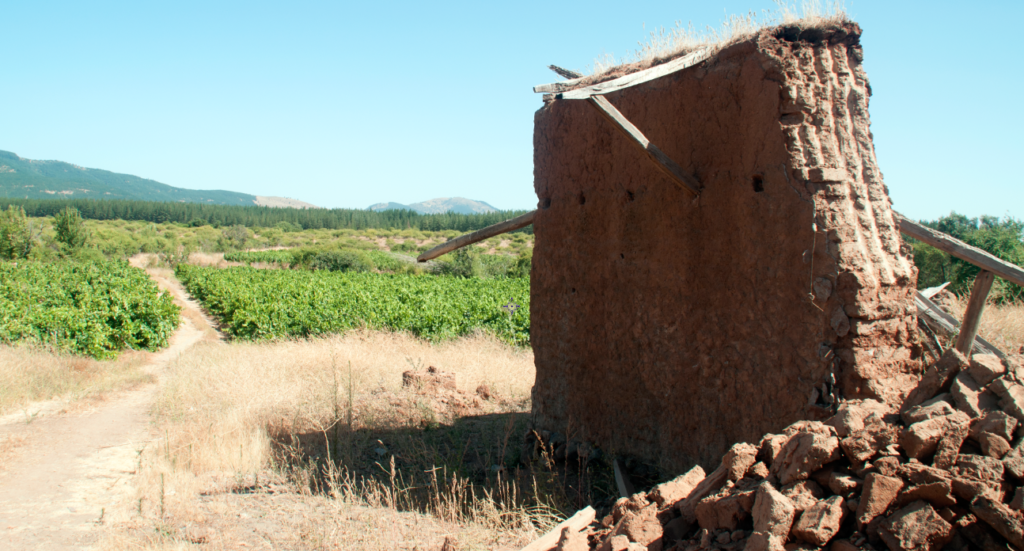 In a bid to improve the wines of Maule and help bring up the prestige of the region, a government advisor brought Carignan to the zone in greater quantities (a small amount had been planted earlier elsewhere) in order to blend in and bolster the acidity, colour and tannins of the weak País wines and rejuvenate a suffering wine industry in the south. Unfortunately, Carignan’s susceptibility to powdery mildew meant that it was largely abandoned within a decade of being planted.
In a bid to improve the wines of Maule and help bring up the prestige of the region, a government advisor brought Carignan to the zone in greater quantities (a small amount had been planted earlier elsewhere) in order to blend in and bolster the acidity, colour and tannins of the weak País wines and rejuvenate a suffering wine industry in the south. Unfortunately, Carignan’s susceptibility to powdery mildew meant that it was largely abandoned within a decade of being planted.
Maule continued to decline and prices fell through the floor as Maule’s wine was relegated to bulk blends and cheap table wine. Large wineries would purchase the grapes at rock bottom prices, and although locals would continue to make their own jug wine, it wasn’t a profitable business model.
Producers looked at alternative options for the land, and the government subsidised the planting of pine trees and eucalyptus. The Pinochet-era scheme is now widely criticised due to the forests’ thirsty, biologically unfriendly and flammable nature. Fears of fire risk sadly proved well-founded in early 2017 when ferocious forest fires devastated 500,000 hectares in the region.
This painful memory is just one chapter in Maule’s long, and often tortured, history. However, Maule is a region that is used to rising from the ashes. In fact, it was another catastrophe – the 2010 earthquake and tsunami – that many wine producers cite as their impetus to start purchasing grapes at higher prices from producers in Maule as a way of helping them get through the tough times. Higher demand and the rising prices of old-vine Carignan (around 98% of the 600 hectares of Carignan in Chile are in Maule) are a source of pride for the producers of Vigno:
 “When we started making Carignan at Odfjell, the going rate was 10 US cents a kilo, today in Chile it isn’t possible to buy a kilo of Carignan for less than US$1.20 to US$1.50!” explains Arnaud Hereu from Odfjell Vineyards. “Imagine the money the producer is making now; with that money he can send his kid to a better school, have a better education and break that vicious cycle they were in. Vigno is more than just a DO; it’s a very important project for an entire region – for Carignan, for the people, for everything!”
“When we started making Carignan at Odfjell, the going rate was 10 US cents a kilo, today in Chile it isn’t possible to buy a kilo of Carignan for less than US$1.20 to US$1.50!” explains Arnaud Hereu from Odfjell Vineyards. “Imagine the money the producer is making now; with that money he can send his kid to a better school, have a better education and break that vicious cycle they were in. Vigno is more than just a DO; it’s a very important project for an entire region – for Carignan, for the people, for everything!”
It so happened that the old Carignan vines were also worth paying a premium for. Winemakers coming to Maule to buy cheap fruit to make table wine began to see the potential of the old-vine Carignan for producing something much, much more interesting. Carignan can be a very vigorous variety but the old age of the vines meant lower yields and concentrated fruit, resulting in grapes that are rich in colour, tannins, acidity and interesting flavours. Although the social impact and heritage conservation are a key part of Vigno’s mission, it certainly isn’t a charity – these vines can make remarkable wines.
Chilean Carignan gains the limelight
While the Vigno concept was clear from the beginning, the making of Carignan wine was not. Although the Carignan vines are old, making premium Carignan was a new concept for Chilean winemakers.
In the 90s a handful of modern pioneers began experimenting with Carignan and, long before the creation of Vigno, they begin to turn to each other for advice. “One thing is Vigno and another is before Vigno…” says Fernando Almeda, winemaker at Miguel Torres, who started working with the variety in 1997 around the same time as a handful of other founding members of Vigno. “In the early 2000s, we would meet up to discuss Carignan, which is how Vigno started.”
The learning curve for making Chilean Carignan was very clear when I had the privilege to do several vertical tastings, stretching back to 2001 (pre-Vigno). “We were treating Carignan like a Bordeaux variety,” explains Andrés Sánchez, reflecting on the winemaking techniques before 2010, when long hang times in the vineyard, extended maceration periods and heavy oak ageing was common. “But now we look at it as a Mediterranean variety – from the perspective of both the vineyard and winery.”
The 2010 vintage most clearly marks the communal shift of style (as you’ll see from tasting notes below), whereby producers began to dial back the oak and pick earlier, highlighting a fresher expression filled with floral, herbal and vibrant fruit notes. Skip forward several years, and the new vintages of Vigno are even brighter. Some producers even use some carbonic maceration – as in the case of new Vigno recruits Bouchon and Concha y Toro – to capture that fresh, youthful style.
This evolution goes hand-in-hand with the changing trends of winemaking in Chile, and for some winemakers within Vigno, Carignan actually influenced their approach to other varieties:
“The click for us at De Martino was Carignan,” says Eduardo Jordán, winemaker at De Martino since 2002. “As a variety, this was the one that made us realise we needed to change our winemaking. It was in 2010 when we really started to make changes in all our wines. This wasn’t just using less oak but we stopped using enzymes, stopped inoculating with foreign yeasts, and we started harvesting earlier (which also meant we didn’t need to acidify.)”
The only winemaking restriction in Vigno is that the wine has to be released at least two years following the harvest and, while De Martino’s minimal intervention approach has been matched by some other producers within Vigno (notably Lapostolle and Garage Wine Co), there remains a range of winemaking techniques and schools within the group. But across the board what is coming out now in Vigno wines is the expression of the different vineyards of Maule – from the wild floral and herbal notes of the Truquilemu/Empedrado vineyard to the dense fruit concentration found in the vineyards of Melozal.
Getting deeper into Maule’s terroir
The definition of vineyards will certainly mark the near future of Vigno as the University of Talca releases its studies on the different mesoclimates and soils of the region. Following two years of measuring weather stations, digging soil pits and making micro-vinifications from specific plots, the University has created a rather smart map of the terroir which shows the soils as well as the climatic influences – which are arguably more important in Maule.
The soils of Maule are some of the oldest soils in Chile being used for viticulture, originating 300 to 400 million years ago and composed of a mixture of granite, clay, rock and sand from the coastal mountain range. When you are dry-farming (as is the case with all the Vigno Carignan vines), the soil and its water-holding capacity are of vital importance significantly influencing the yield and quality. Carignan is actually one of the few grape varieties hardy enough to survive the harsh conditions here (between poor soils, dry-farming and the hot summer sun) and the mesoclimates, created by the sloping hillsides and coastal influence, also have a big role to play.
“The soil is important, but the microclimate can have a bigger influence in Maule’s vineyards,” says Eduardo Jordán, winemaker at De Martino. “Empedrado is the same distance from the sea as Sauzal, for example, but you have to harvest a month later because the grapes take longer to ripen!”
The moment of harvest is also important and, even in the same vintage, Vigno’s wines have had alcohol levels ranging between 11% and over 15%. With the new studies available, the moment of harvest may be easier to judge and I expect the 2018 vintage will be another landmark vintage for this very reason.
Another exciting development following the research is that Vigno will now start certifying Vigno vineyards, rather than just wine producers. Currently, there are only a dozen vineyards being used for Vigno wines. According to Gastón Gutierrez from University of Talca, the study results show approximately 120 vineyard holdings of dry-harvested Carignan in Maule which could potentially qualify for Vigno certification.
This could spell an increase in Vigno wine production and it also marks the first verification of not just the provenance but the quality of grapes in Chile. As Vigno continues to make leaps forward into Chile’s terroir-driven future, it is refreshing to see so many innovations and advances spring from one of Chile’s oldest and most traditional wine regions.
While Vigno has had its share of growing pains, much like Chilean Carignan and the territory of Maule, as it reaches adulthood Vigno looks set to continue as the forebearer of Chile’s modern appellation system.
Vigno wine tasting notes
I had the privilege of tasting several verticals and all the current collection of Vigno wines. Here are my tasting notes. While I’m not a fan of points, all of the wines listed are worth trying (85+ points) and I’ve marked in purple the standout wines.
Miguel Torres Vigno
Current vintage:
Miguel Torres, Cordillera Vigno 2014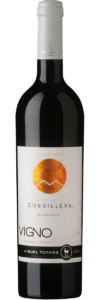
This 100% Carignan spends a year in old and new oak but still shows mainly fruit on the nose with delicious warm cassis and boysenberry notes with a refreshing lift of dried bay leaf. The nose is more mellow, but in the mouth, there is a tight acidity and vibrancy.
More info on Miguel Torres Carignan
Vertical Miguel Torres Carignan tasting notes:
Miguel Torres Carignan 2007
This blend of 66% Carignan with 16% Syrah and 18% Merlot pre-dates Vigno and although it is over a decade old it is still quite youthful for its years. The composition is very different to their current Vigno vintage and the blend is meaty on the nose with bloody animal notes from the Syrah and rich, ripe berry fruit. The spicy tannins and spine of acidity hold the concentrated fruit together, and it has a smooth finish.
Miguel Torres Vigno 2010
This was the first vintage that Torres made their first 100% Carignan and it was a cooler, later vintage which shows darker fruit notes on the nose. The lively acidity lifts the palate and finishes with an aromatic note of vibrant fresh fruit and peppery spice. Showing really well at the moment.
Miguel Torres Vigno 2011
This feels like a much plusher vintage with more confit red fruit aromas and a richness to the palate. This is a smooth Carignan with an attractive and aromatic finish.
Miguel Torres Vigno 2014
This vintage marks a bigger change in the winemaking style and there is much more vibrant fresh fruit – see the tasting note above.
Miguel Torres Vigno 2015
This 100% Carignan comes from slightly different vineyards than the last couple of vintages and juicy blueberry fruits. It hasn’t been released yet but I loved the vibrancy of this wine with refreshing and bright juicy fruit, some spice and a lively acidity.
Overall impressions on Torres Carignan:
Torres is one of the bigger producers of Vigno Carignan (in production numbers) and is possibly the easiest to access for wine drinkers around the world. I think this is a great wine as an introduction to Vigno Carignan – it offers an approachable insight into the character of old vine Carignan in Maule. Each year the blend changes slightly, and the winemaking is gradually erring towards fresher fruit expression in the later vintages, however, Torres Carignan has maintained a consistent focus on balancing fruit concentration with spice from oak ageing and making a round wine (although all Carignan remains a bit spikey!)
Gillmore Wines Vigno
Current vintage:
Gillmore Wines Vigno 2014
With bright red berry fruit, this 100% Carignan comes from old vines in Loncomilla and has a rich, fruit-forward nose but in the mouth, it has a wonderful freshness with slightly more herbal notes of wild mint and dried leaves. Wonderful freshness on the finish.
Vertical tasting of Gillmore Wines Carignan
Gillmore Wines Carignan 2008
This older vintage has moved on to more savoury notes in the nose but there are still some confit fruit notes lingering underneath the dried leaf notes and forest herbs. There’s spice and length to this wine, with a very appetising finish.
Gillmore Wines Carignan 2009
This vintage shows darker notes of liquorice, black olive and petrol – it is a savoury wine with a dark and spicy character.
Gillmore Wines Carignan 2010
This vintage showed a distinct switch from the other two previous vintages, and – although similar in age – the wine is filled with bright fruit notes and has a vibrancy and freshness. There’s still the trademark wild herbal aromas of the region, and this vintage is showing particularly well.
Gillmore Vigno 2011
This vintage also shows lots of juicy fruit notes and has a wonderful brightness of character lined by a good spine of acidity and spicy tannins that make your mouth pucker.
Gillmore Vigno 2012
Another good vintage that shows warmer fruit on the nose with a bright floral and forest herbal note that keeps it very lively. A vibrant wine with tension and acidity. This will continue to age well.
Overall impressions of Gillmore Carignan:
All of the wines had a trademark note of fresh forest herbs – think eucalyptus, wild mint and bay leaf – that clearly comes from the old vineyard they own in Loncomilla. 2010 marked a change in style but the wines were consistently fruit-focused and the younger vintages show real brightness.
De Martino
Current vintage:
 De Martino Vigno 2015
De Martino Vigno 2015
With around 15% Malbec and other varieties from the same vineyard, this is more of a Carignan field blend but has a transparent expression using neutral vessels (stainless steel and 5000-litre foudre) and is perhaps still a little young to show its full expression. Dried herb and leaf notes emerge from the glass at a more relaxed pace and the mouth is refined with spicy but smooth tannins. A grower, not a shower.
Vertical tasting of De Martino Vigno Carignan:
De Martino Vigno 2009
This older vintage has a nice smoked pepper nose and dried bay leaves. The harvest date was clearly a bit later with a riper nose of mature fruit, however it remains quite bright in the mouth.
De Martino Vigno 2011
This vintage sees a very different style of winemaking – winemaker Eduardo says the change really started in 2010 – and the nose shows some darker fruit notes with aromas of black olive and some cooking spice. Supple in its age, vertical in its style and quite delicious.
De Martino Vigno 2012
This was a slightly warmer year than 2011 and in the mouth, there is plusher fruit coming through however it also shows plenty of freshness with floral notes and spice.
De Martino Vigno 2013
Bacon notes give this wine a much meatier aroma although there are the subtle dried leaf and herbal nuances underpinned by dark fruit and spicy tannins which give this a long and lasting finish. Another wine to linger over.
De Martino Vigno 2014
This has much more concentration but also great vibrancy with a concentrated acidity. It’s a lively wine and is beginning to come into its own after a couple years bottle ageing.
Overall impressions of De Martino Carignan:
In terms of winemaking style shifts, De Martino’s has been seismic. Previous to 2010 the wines were made following long hanging times in the vineyard with more concentration and a bigger oak presence. Today they couldn’t be more different. Minimal intervention is the name of the game at De Martino and the wines are all very drinkable for this reason. Carignan can be a particularly showy grape (as it is in many of the other Vigno wines) however De Martino’s representation of the variety has a more refined and understated character. It can suffer somewhat in a lineup with the other Vigno wines – it is notably quieter – but the vertical allowed me to experience the differences between vintages and the unique character of every year’s field blend. I recommend uncorking De Martino Carignan on its own, and let the wine begin its conversation with you in its own time.
Odfjell Vineyards
Current vintage:
 Odfjell Vigno 2014
Odfjell Vigno 2014
There is a lot of perfume on the nose with floral notes backed by plusher red fruit. This has been aged in new French barrels and the warm spice and vanilla bean heighten the flamboyant fruit. A spine of acidity and peppery tannins hint at long ageing potential but you can equally enjoy it today. An unabashedly showy wine.
More info on Odfjell Vineyards.
Vertical tasting of Odfjell Carignan:
Odfjell Orzada Carignan 2001
This has a much more animal note (with some brett) that accentuates aromas of leather, cigar and alcohol-soaked cherries. There is around 15% of Cabernet Sauvignon in the blend and the mouth is surprisingly still fresh with great energy.
Odfjell Orzada Carignan 2004
This vintage shows sweet fruit on the nose – almost Port-like – reflective of a later harvest with much riper, confit fruit on the nose. The mouth is plush and full which has lots of ripe fruit expression and sweet, smooth tannins.
Odfjell Orzada Carignan 2008
This vintage is much darker in the nose with notes of spice, dark plum and dark cherries. In the mouth there is a grippy acidity and long dry spice on the finish.
Odfjell Orzada Carignan 2010
This vintage shows wonderful dark notes with graphite, spice and dark fruit. It is a very compact wine that shows an age-worthiness. Spicy and fresh.
Odfjell Orzada Carignan 2012
This vintage was the first that I didn’t use any oak, it was all made in stainless steel and it shows much more fruit on the nose with bright berry fruit and a very juicy, fresh mouthfeel. It is a sharp wine full of fruit.
Odfjell Orzada Carignan 2014
With no oak, this is filled with more fruit notes and bright floral notes from the vineyard. The mouth is juicy and vibrant, it is alive and very bright.
Overall impressions from Odfjell Carignan:
Winemaker Arnaud has gone on a slightly different route to the other Vigno winemakers – his Vigno has increased the oak presence over time. He also has the opportunity to make two Carignans with Odfjell (they own a large old-vine Carignan vineyard in Maule), so while his Vigno wine has more perfumed oak, his Odfjell Orzada wine strips back to the bare Carignan and is fruit-forward. They make an excellent comparison point and I wouldn’t hesitate to say there will be fans of both styles. Orzada is naked Carignan, Vigno is Carignan wearing red lipstick and a fur coat.
Meli Vigno
Meli Vigno 2014
This 100% Carignan jumps from the glass with bright notes of red and blue fruit, and a sharp acidity and aromatic finish. After time in the glass, this opens up and offers slightly chewier meaty notes.
Morande
 Morande Vigno 2015
Morande Vigno 2015
One of the younger vintages on current release, this is a co-fermentation of Carignan with 18% Syrah and 4% Chardonnay is the first harvest which winemaker Ricardo Baettig envisioned from the start and it marks a turnaround for the winery style. There is dark fruit concentration in this wine but it is lively in the mouth with juicy acidity and plenty of spice and meadow herbs. Bright and quite fun.
More info on Morande wines and Vigno and their experimental wines
Valdivieso
Current release:
 Eclat Vigno 2010
Eclat Vigno 2010
Rich, meaty and spicy, this Carignan is blended with 33% Mourvedre which gives it much more structure and a dark fruit expression. This still feels youthful despite its 7 years and there is a good acidity that keeps this wine together and will give it a long cellar life.
Vertical tasting of Eclat Carignan:
Eclat Carignan 2004
On sight, the vibrant purple of young Carignan has notably transitioned into a deep Burgundy colour and the fruit is evidently more evolved but this wine is still alive for almost 15 years of age. I recommend drinking this up now while the fresh acidity still lifts the more mature, evolved characteristics.
More info on Eclat and Valdivieso wines
Garcia + Schwaderer
Garcia + Schwaderer Vigno 2014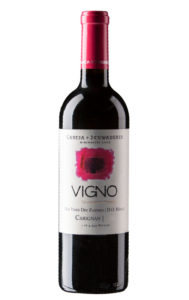
With 21 months in French oak, this pure Carignan takes a little while to open but when it does a heady concoction of bright fruit, flowers and herbs unfold. In the mouth, it has a fuller body with spice and an acidity that puckers your lips and clears the palate. This is an intense wine of contradictions and it engages your brain while you drink it.
More info on PS Garcia (formerly Garcia + Schwaderer) wines
Bouchon Family Wines
 Bouchon Vigno 2015
Bouchon Vigno 2015
One of the newest additions to the VIGNO portfolio, Bouchon’s 2015 vintage comes from the same vineyard as Garcia + Schwaderer and Eclat, however, this is a very different style with a touch of carbonic maceration. The fruit and fresh herbal notes jump out of the glass and it has a bright and juicy mouthfeel with an effusive acidity. It is lively and probably the lightest of the VIGNO wines. Definitely a fun wine to try – especially in a comparative tasting.
Undurraga
Terroir Hunter Vigno 2014
With blue and blackberry fruit in the nose, this Carignan has a floral perfume and wild herbal note. It is attractive, juicy and modern – this wine might play it safe but it is an excellent example of old vine Chilean Carignan. Accomplished.
Garage Wine Co
Garage Wines Vigno 2014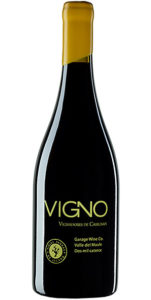
With a bit of Mourvedre in the blend, this wine has wonderfully aromatic meadow flower notes and something that reminds me of a fine Bourbon! It is slightly wild and animal too, but is predominantly driven by fresh fruit and floral notes. A lively and playful wine.
Lapostolle
Lapostolle Collection Vigno 2015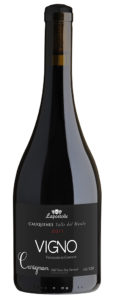
One of my absolute favourites from the Vigno line up – fresh, bright and vibrant. This is a flirty wine with very expressive cassis, berry fruit, floral and meadow notes. It comes from the same vineyard as Garage Wine Co, and that fresh character is clearly linked to this cooler climate with more coastal influence. This is a small production made by winemaker Andrea Leon within a special Lapostolle collection.
Concha y Toro
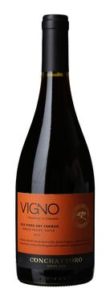 Concha y Toro Vigno 2014
Concha y Toro Vigno 2014
With around 10% of carbonic maceration, this wine has lots of bright fruit notes emerging from the glass. In the mouth, it is quite light and juicy with a freshness to it and soft tannins. The finish is aromatic with lingering red fruit notes. This is an interesting addition to the Vigno portfolio, coming from the country’s biggest producer.
Alcance
Alcance Vigno 2015
Owned by Kendall-Jackson, this comes from beautiful old vines and has a concentration of fruit with plenty of spice on the finish. It has pretty, floral notes too and a nice freshness in the mouth. This is a lively and juicy wine, utterly drinkable.
More on Maule terroir, Vigno and old vine Carignan:
- Maule Fast Facts & Terroir Essentials
- Carignan Profile
- What is VIGNO?
- Maule and the Carignan boom
- The diversity of Maule terroir
- Wine Drinking with Wine Makers: Arnaud Hereu and Andres Sanchez

